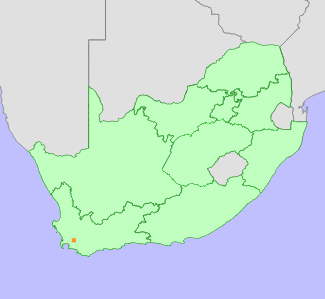|
Scientific Name | Serruria florida (Thunb.) Salisb. ex Knight |
Higher Classification | Dicotyledons |
Family | PROTEACEAE |
Common Names | Blushing Bride (e), Pride-of-franschhoek (e), Skaamblom (a), Trots-van-franschoek (a) |
National Status |
Status and Criteria | Critically Endangered A3c; B1ab(iii,v) |
Assessment Date | 2020/06/17 |
Assessor(s) | A.G. Rebelo & D. Raimondo |
Justification | Serruria florida is a highly restricted endemic known from one location from the mountains near Franschhoek in South Africa. It has an extent of occurrence (EOO) and an area of occupancy (AOO) of 24 km². The only remaining population is experiencing slow ongoing decline as a result of habitat degradation from the spread of invasive alien woody plant species and too infrequent fires. A major future threat to the species is the proposed development of water boreholes to supply the Western Cape with additional water from underground aquifers, should this development take place over 80% of the population will be lost. |
Distribution |
Endemism | South African endemic |
Provincial distribution | Western Cape |
Range | This species is known from Franschhoek, Assegaaiboskloof, in the Western Cape Province of South Africa. |
Habitat and Ecology |
Major system | Terrestrial |
Major habitats | Kogelberg Sandstone Fynbos, Boland Granite Fynbos |
Description | It occurs on granite slopes, 600-620 m. Mature individuals are killed by fires, and only seeds survive. Seeds are released after ripening, and dispersed by ants to their underground nests, where they are protected from predation and germinate following fire. It is pollinated by insects. This is a fire ephemeral, flowering at three years following fire, peaking between five and eight years, and then rapidly declining to a few senescent plants by 20 years. |
Threats |
| Threatened in the past by afforestation (Pines) over 50% of the only remaining location at Assegaaiboskloof was planted to pines between 1950 and 1970. In the early 2000s forestry activities ceased and there has been some recovery of this population following a fire that passed through the former plantation. Illegal wild flower harvesting was also a past threat but is not longer taking place. As this species is highly dependent on fire for its ecology too-infrequent fires due to fire exclusion management is a concern, and there have been long periods where this species' habitat has not been burnt. There is ongoing pressure from invasive alien pines and hakeas, fortunately the site has been cleared of aliens by volunteer groups and by working for water teams, however these efforts need to continue. The most severe current threat is the proposed construction of emergency water relief facilities, over 20 boreholes, pumping stations, their pipelines and electricity were planned to be erected in 2018 to relieve the severe drought conditions that the Western Cape was under between 2016 and 2018. However these have not yet been built but remain likely to be constructed should the Western Cape enter another drought period which is probable given climate change predictions. Should this construction take place over 80% of the population will be lost. |
Population |
Over 3,000 plants occur in the upper section of Assegaaiboskloof, numbers of mature individuals fluctuate in response to fire with there being many plants present three to eight years following fire and then becoming very scarce as the vegetation ages. While there were regular fires in the late 1990s and early 2000s and the population was very healthy between 2005 and 2010, there has been no burns since 2005 leaving the vegetation moribund with few Serruria florida plants present. This species has soil stored seed banks that germinate following fire, it does therefore not qualify for population fluctuations as defined by the Guidelines for using the IUCN Red List Categories and Criteria. The population is suspected to be declining at a slow rate as a result of habitat degradation from invasive alien plant species. This species was historically also recorded from Skelmhoek and Franschhoek Pass but have not been recorded at either site since 1945, the cause of loss is unknown but is suspected to be due to excessive wildflower harvesting.
|
Population trend | Decreasing |
Conservation |
| About half the known distribution range and 80% of the current population occurs in the Hottentots-Holland Nature Reserve. The remainder of the current subpopulations are due to be handed over to conservation when the plantations are removed and the aliens cleared. |
Assessment History |
Taxon assessed |
Status and Criteria |
Citation/Red List version | | Serruria florida (Thunb.) Salisb. ex Knight | CR B1ab(i,ii,iii,iv,v)c(iv)+2ab(i,ii,iii,iv,v)c(iv) | Raimondo et al. (2009) | | Serruria florida (Thunb.) Salisb. ex Knight | Vulnerable | Hilton-Taylor (1996) | | Serruria florida (Thunb.) Salisb. ex Knight | Endangered | Hall et al. (1980) | |
Bibliography |
Goldblatt, P. and Manning, J.C. 2000. Cape Plants: A conspectus of the Cape Flora of South Africa. Strelitzia 9. National Botanical Institute, Cape Town.
Hall, A.V., De Winter, M., De Winter, B. and Van Oosterhout, S.A.M. 1980. Threatened plants of southern Africa. South African National Scienctific Programmes Report 45. CSIR, Pretoria.
Hilton-Taylor, C. 1996. Red data list of southern African plants. Strelitzia 4. South African National Botanical Institute, Pretoria.
Manning, J.C. and Goldblatt, P. 2012. Plants of the Greater Cape Floristic Region 1: The Core Cape Flora. Strelitzia 29. South African National Biodiversity Institute, Pretoria.
Raimondo, D., von Staden, L., Foden, W., Victor, J.E., Helme, N.A., Turner, R.C., Kamundi, D.A. and Manyama, P.A. 2009. Red List of South African Plants. Strelitzia 25. South African National Biodiversity Institute, Pretoria.
Rebelo, T. 2001. Sasol Proteas: A field guide to the proteas of southern Africa. (2nd ed.). Fernwood Press, Vlaeberg, Cape Town.
|
Citation |
| Rebelo, A.G. & Raimondo, D. 2020. Serruria florida (Thunb.) Salisb. ex Knight. National Assessment: Red List of South African Plants version 2024.1. Accessed on 2026/01/01 |
 Comment on this assessment
Comment on this assessment

